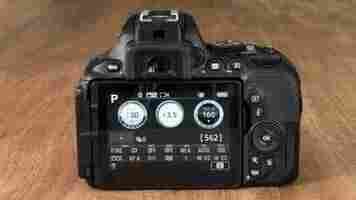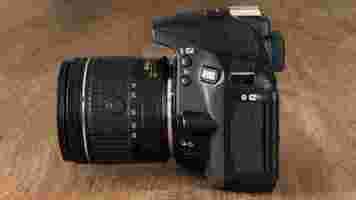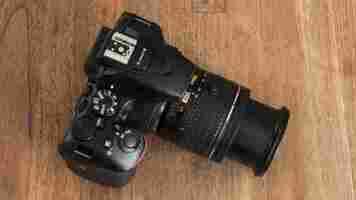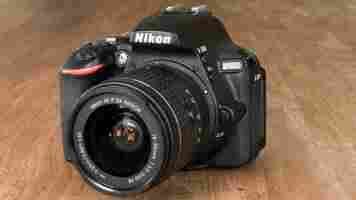Nikon D5600 review: A mild update to an already excellent camera
The D5600 is Nikon’s latest consumer-oriented SLR, designed for people who are serious about photography but who aren’t necessarily aspiring professionals. Features such as a 39-point autofocus system, articulated touchscreen, built-in Wi-Fi and microphone socket differentiate it from the entry-level Nikon D3400. You don’t get the Nikon D7500’s larger viewfinder, 51-point autofocus and 8fps burst shooting, but then the D5600 doesn’t cost £1,300.
READ NEXT: The best SLRs, CSCs and compact cameras in 2017
Nikon D5600 + AF-P 18-55 VR DSLR Camera - Black £619.00 Buy now
Nikon D5600 review: Controls and layout
This is one of the smallest SLRs on the market but there’s a substantial handgrip to ensure a secure fit in the hand. The 3.2in LCD touchscreen is bigger than the usual 3in screens, although this is more likely to be appreciated while reviewing shots rather than capturing them since most people will default to using the viewfinder during shooting. The 820-shot battery life is way ahead of rivals at this price.
There are lots of buttons dotted around the camera but this is not my favourite control system. The four-way pad is permanently assigned to autofocus point selection, but it’s quicker to adjust this by swiping the screen while composing shots with the viewfinder – a handy feature you have to enable in the menu as it’s not switched on by default. There are labelled buttons for zooming into and deleting photos but they’re redundant during normal shooting and can’t be reassigned. The zoom out button doubles as a Help function, giving handy, context-sensitive tips.

There are no dedicated buttons for white balance, JPEG/RAW quality, focus mode or metering mode. These are available via the "i" button, which instead reveals a quick-access menu of 14 functions on the touchscreen. The physical Fn button is assigned to ISO speed by default — a sensible choice — but it’s not possible to toggle Auto ISO on and off here. This requires a trip to an obscure submenu.
With Auto ISO enabled, the LCD screen shows the current ISO speed but, annoyingly, this information doesn’t appear in the viewfinder. There’s no option to show exposure information when reviewing shots, either. As a result, it’s hard to keep an eye on the ISO speed when shooting using Auto ISO and the viewfinder.
Drive mode has its own button but it took me a while to find it, tucked away around the front of the camera. This includes a self-timer option, but choosing between a ten-second self-timer (for group self-portraits) and a two-second timer (for avoiding shake on tripod-mounted shots) requires another trip to the main menu. The self-timer resets after each use, too, which is a nuisance for repeated tripod shots such as macro or studio photography. Admittedly, the camera's Exposure Delay Mode function serves the same purpose and can be selected in the Shooting > Display submenu, but that means the two-second delay function seems largely redundant in its current form.
Ultimately, these issues with the controls are niggles rather than major inconveniences and routine operation is generally comfortable and straightforward. There’s room for improvement, though.

Nikon D5600 review: Connectivity
SnapBridge support is the main — almost only — new feature in the D5600 compared to the D5500 that it replaces. This uses a combination of Bluetooth and Wi-Fi to communicate with a smartphone or tablet. Bluetooth maintains a constant connection, handling JPEG transfers and Wi-Fi is only invoked when remote operation is required.
NFC is included, too, to speed up initial set-up and this worked flawlessly with an Android phone in my tests, even down to syncing the time from phone to camera. From then on, 2-megapixel copies of photos were transferred within seconds of being captured, without needing to select it actively on either device even after the camera was switched off.
This inevitably will have an effect on battery life but it’s a great feature for being able to review shots on a bigger tablet screen, perhaps on your journey home. Depending on your device’s cloud sync settings, photos should also then appear in your online photo album automatically, too.

However, I did experience problems with this. After a couple of days the automatic link was lost and it proved extremely tricky to re-establish it. The camera repeatedly told me it had successfully paired but the app reported it had failed. I also had difficulties connecting to an iPad, which lacks NFC so requires manual Bluetooth pairing before it can proceed. User reviews of the apps suggest that this kind of experience isn’t uncommon.
Nikon D5600 review: Performance and autofocus
Elsewhere, general performance is in line with the Nikon D5500. The D5600 will capture a shot every 0.4 seconds in normal use and this slows to 2.9 seconds when composing shots using the LCD screen. It’s a common issue for SLRs but the Canon EOS 750D is much faster. Continuous shooting was at 4.8 shots for 17 JPEGs or eight RAW frames before slowing to the speed of the card.
The 39-point autofocus sensor and Nikon’s 3D Tracking feature means the camera can track moving subjects around the frame with a reasonable degree of reliability. This camera doesn’t have the sustained performance required for serious action photography but it’s still handy for shooting moving subjects such as children. The generous number of autofocus points also means you can focus precisely on the subject’s eyes without having to focus, recompose the scene and then shoot.
Nikon D5600 review: Video quality
Videos are recorded at 1080p resolution at frame rates up to 60fps. There’s a choice of automatic or manual exposure, but not shutter- or aperture-priority. However, the maximum recording time has increased from 10 to 20 minutes for 50fps and 60fps clips.
Picture quality is respectable with flattering colours and low noise, but details aren’t quite as crisp as from the best 1080p SLRs and, inevitably, it's far behind 4K cameras’ output.
There’s no continuous autofocus for video, either. Updating focus requires either a half-press of the shutter button or a tap on the touchscreen. This works pretty well, avoiding unnecessary focus hunting when your subject is relatively static, and the kit lens is responsive yet quiet.
